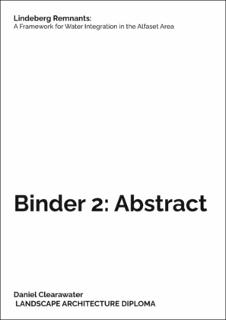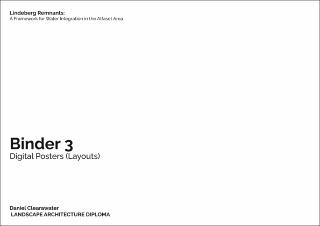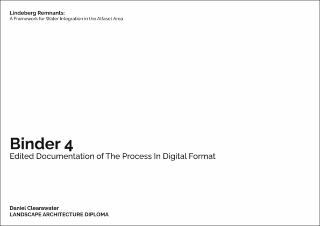| dc.contributor.advisor | Helms, Karin | |
| dc.contributor.author | Clearwater, Daniel | |
| dc.coverage.spatial | Groruddalen, Oslo, Norway | en_US |
| dc.date.accessioned | 2024-02-28T09:23:45Z | |
| dc.date.available | 2024-02-28T09:23:45Z | |
| dc.date.issued | 2023-12 | |
| dc.identifier.uri | https://hdl.handle.net/11250/3120243 | |
| dc.description | Spatial transformations during th 20th century due to urban and infrastructural developments led to the fragmentation of surface-water in the Alna watershed resulting in diminsing the ecosystem. Centered on the Lindeberg basin within the Alna watershed, the site is characterized by impermeable surfaces.
This project explores the potential of these untapped spaces to promote the absorption and guiding of surface-water to bolster hydrological integration and ecosystem resilience.
Context
Several creeks within the Alna watershed have been fragmented and/or culverted due to developments in the 20th century. As a result stormwater and runoff find their way to where these creeks once existed on impermeable grounds. The new topsoil layer does not allow for water to infiltrate or ecosystems dependent on waterways to exist. Creeks that connected different species and defined land boundaries disappeared.
Methods
Through historical and present cartography, tracings, walks and photography, Alfaset in the center of the watershed is identified with abundant surface-water and high ratio of impermeable surfaces. The Lindeberg basin in the Alfaset upstream has the potential to connect two rich biotopes of the Alna river and the Østmarka forest and is chosen as a microcosm for the Alfset area.
The site witnessed glacial processes that left landforms such as esker ridges, kettle depressions and terminal moraines that shaped the water movement and behavior. These inspire introducing similar landforms that guide and hold the water before they flow seamlessly downstream.
Cracking the asphalt layer allows for the water to inflirate. The residue material helps introduce ridges that guide the water and depressions and terminals that hold and slow down the flow of water. This enables surface-water to revive the identity of the valley. Once characterized by farms that rested around waterescapes.
The chosen Lindeberg basin connects the most developed forest along the Alna river with a biodiverse segment of the Østmarka forest. Thus, increasing the resilience of these biotopes and their subsequent species. Further, it creates a new connection for the residents in the Lindeberg area through the creek to the Alna park, which currently has very limited access to the local residents.
Conclusion
The new spaces introduced in Lindeberg are aimed as an archetype to create new hydrological integration in the Bredtvet/Veitvet basin, the Alna river/Alfaset basin and the Trosterud/Haugerud basin. This project connects the condition of topsoil with surface-water integration and the spatial connection for the residents at the bottom of the Grorud valley. | en_US |
| dc.language.iso | eng | en_US |
| dc.publisher | The Oslo School of Architecture and Design | en_US |
| dc.subject | Landskapsarkitektur | en_US |
| dc.subject | Landscape architecture | en_US |
| dc.subject | Urbanisme | en_US |
| dc.subject | Urbanism | en_US |
| dc.subject | Lindeberg | en_US |
| dc.subject | Vannskille, Alna | en_US |
| dc.subject | Vann i by | en_US |
| dc.subject | Overflatevann | en_US |
| dc.subject | Elver og bekker | en_US |
| dc.title | Lindeberg Remnants: A Framework for Water Integration in the Alfaset Area | en_US |
| dc.type | Master thesis | en_US |
| dc.description.version | submittedVersion | en_US |
| dc.rights.holder | Daniel Clearwater | en_US |
| dc.subject.nsi | VDP::Humanities: 000::Architecture and design: 140::Landscape architecture: 147 | en_US |


